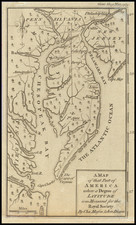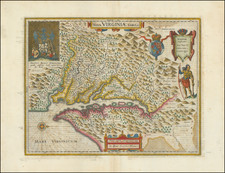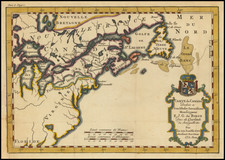A rare and finely engraved plan of the Battle of Elizabeth Town, New Jersey (1780), published by William Faden, after a manuscript by the great military cartographer John Hills.
The present example is an extremely rare restrike from the original plate, apparently printed in very limited numbers in the middle of the 19th Century, using the original copper plate.
This fine map depicts the Battle of Elizabeth Town (which actually consisted of 2 altercations fought on June 8 and 23, 1780), during the last major British campaign in the northern theatre of the American Revolution. As depicted on the map, this battle was fought on fields that lay to the south of the village of Elizabeth Town (today know simply as Elizabeth), a position bordered on three sides by salt marshes and water.
In the Spring of 1780, the British firmly controlled Manhattan, while New Jersey was under the auspices of the Americans, who were headquartered at Morristown. The situation remained both tense and fluid, as the Americans were ever vigilant for a enemy attacks from across the Hudson.
Lieutenant General Wilhelm von Knyphausen (1716-1800), a Hessian Baron who served as the British commandant of New York, decided to launch an invasion of New Jersey. Knyphausen's force of 6,000, mostly German mercenaries, encountered sharp resistance at Connecticut Farm, New Jersey, from a smaller but highly motivated American force under General Nathaniel Greene. Nevertheless, Knyphausen was able to proceed to Springfield Bridge, but the Americans managed to check him and to force him to retreat to the area of Elizabeth Town.
The action portrayed on the map begins on the morning of June 8, 1780, with the depiction of Knyphausen's lines assembled in a defensive position as if to ward off a siege (as indicated by 'A' on the map). With the various British regiments carefully labeled and distinguished with their own color, the map indicates how Knyphausen's lines were forced to contract inwards in response to an American assault. However, the arrival of reinforcements (B) saved the British from having to give up further ground, such that they eventually came to occupy a better position on elevated land.
In spite of this lackluster performance, the British force remained a viable threat to the American control of the area, as George Washington's army in Morristown was ill-prepared to face a well-orchestrated British assault. On June 23, the British again encountered the Americans at Springfield Bridge, but this time they were decisively defeated, forcing them to make a hasty retreat to the relative safety of Staten Island across the improvised bridge depicted on this map (E).
In sum, at Elizabeth Town, the British squandered a magnificent opportunity to take control of New Jersey, and thus to severely threaten George Washington's plans to conclude the war on American terms.
William Faden (1749-1836), the Geographer to the King, ascended to the apex of the London map world based on his groundbreaking cartography of the American Revolution. Faden included the present map in his exceedingly rare Atlas of Battles of the American Revolution (London, 1784), although some examples were also issued separately.
The map is based, on a now lost manuscript map, by John Hills, one of the most talented and prolific cartographers of the Revolutionary War, and a direct eyewitness to many of the events captured by his maps. John Hills ( fl. 1777-1816) served as Ensign in the 38th and later as a lieutenant in the 23rd regiment. Hills's abilities were greatly valued by his superiors even though his mercurial personality frequently led him into violent altercations with fellow officers and civilians alike.
While serving in the Philadelphia Campaign of 1777-8 and later actions in the New Jersey theatre, Hills drafted a magnificent series of manuscript battle plans, and larger regional campaign maps. It would appear that he was apprised of the most advanced civilian surveys, having had access to the original maps contained in the archives of the Proprietors of East Jersey, which had been seized by the British from the provincial capital, Perth Amboy. Hills also seems to have been in contact with various local surveyors in both New Jersey and Pennsylvania. His greatest work was the manuscript atlas of 20 maps of parts of New Jersey he made in 1780 for the British Commander-in-Chief, Sir Henry Clinton, now preserved in the Library of Congress. Included in this atlas is a "Plan of the road from Elizabeth Town Point to Elizabeth Town: shewing the rebel works raised for its defence", which shows the battle site immediately prior to the first action of June 8, 1780. This map was surely used in the preparation of the manuscript on which the present map is based.
Following the war, Hills settled in Philadelphia, and existing manuscripts shows that as early as 1788, he was working as professional draftsman and surveyor. In 1796, with the support of Philadelphia's mayor, Matthew Clark, Hills completed the most important survey of the city of the Post-Revolutionary generation. This was published as A Plan of the City of Philadelphia and its Environs (London, 1798), and is today a landmark of early American urban cartography.
The Faden-Hills plan of the Battle of Elizabeth Town is a rare and important artifact documenting the Revolutionary War, and one of the few printed battle plans relating to New Jersey.
William Faden (1749-1836) was the most prominent London mapmaker and publisher of the late-eighteenth and early-nineteenth centuries. His father, William Mackfaden, was a printer who dropped the first part of his last name due to the Jacobite rising of 1745.
Apprenticed to an engraver in the Clothworkers' Company, he was made free of the Company in August of 1771. He entered into a partnership with the family of Thomas Jeffreys, a prolific and well-respected mapmaker who had recently died in 1771. This partnership lasted until 1776.
Also in 1776, Faden joined the Society of Civil Engineers, which later changed its name to the Smeatonian Society of Civil Engineers. The Smeatonians operated as an elite, yet practical, dining club and his membership led Faden to several engineering publications, including canal plans and plans of other new engineering projects.
Faden's star rose during the American Revolution, when he produced popular maps and atlases focused on the American colonies and the battles that raged within them. In 1783, just as the war ended, Faden inherited his father's estate, allowing him to fully control his business and expand it; in the same year he gained the title "Geographer in Ordinary to his Majesty."
Faden also commanded a large stock of British county maps, which made him attractive as a partner to the Ordnance Survey; he published the first Ordnance map in 1801, a map of Kent. The Admiralty also admired his work and acquired some of his plates which were re-issued as official naval charts.
Faden was renowned for his ingenuity as well as his business acumen. In 1796 he was awarded a gold medal by the Society of Arts. With his brother-in-law, the astronomer and painter John Russell, he created the first extant lunar globe.
After retiring in 1823 the lucrative business passed to James Wyld, a former apprentice. He died in Shepperton in 1826, leaving a large estate.










![[The First Maps Printed Color] Cartes en Couleur des Lieux Sujets aux tremblements de Terre Dans toutes les parties du Monde Selon le Sisteme de l’impulsion Solaire](https://storage.googleapis.com/raremaps/img/small/52293op.jpg)


![[Carolinas, Virginia, the Chesapeake, Pennsylvania, New York]](https://storage.googleapis.com/raremaps/img/small/71479.jpg)
![[Right sheet only of: A New Chart of America Florida to New York with the Principal Harbours on a Large Scale, Drawn from the latest Authorities, by Robt Blachford. 1807.]](https://storage.googleapis.com/raremaps/img/small/55819.jpg)